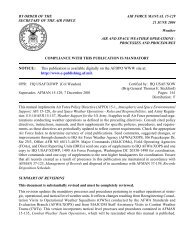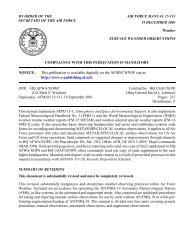Joint Metoc Handboo - IHMC Ontology and Policy Management
Joint Metoc Handboo - IHMC Ontology and Policy Management
Joint Metoc Handboo - IHMC Ontology and Policy Management
Create successful ePaper yourself
Turn your PDF publications into a flip-book with our unique Google optimized e-Paper software.
10-USMC<br />
Environmental Subsystem (NITES) version I, principal METOC analysis <strong>and</strong> fusion<br />
system, <strong>and</strong> NITES version II, GCCS-M, METOC input to mission planners. It will be<br />
Defense Information Infrastructure (DII)/Common Operating Environment (COE)<br />
compliant <strong>and</strong> compatible with evolving joint communication <strong>and</strong> METOC<br />
architectures.<br />
• Communications Subsystem (CMS). The CMS enables the MetMF(R) to transmit <strong>and</strong><br />
receive secure <strong>and</strong> non-secure METOC data from meteorological channels, worldwide<br />
meteorological broadcast frequencies, <strong>and</strong> satellite communications. The CMS will<br />
have interoperable connectivity between the various other subsystems of MetMF(R),<br />
the MAGTF C 4 I Local Area Network (LAN), <strong>and</strong> joint/government agencies <strong>and</strong> allied<br />
nations via the GCCS-M. Two-way communications is accomplished through existing<br />
Marine Corps communication infrastructure, normally the SIPRNET.<br />
• Meteorological Satellite Subsystem (MSS). The MSS receives both high <strong>and</strong> lowresolution<br />
meteorological imagery from polar orbiting satellites <strong>and</strong> low-resolution<br />
meteorological imagery from geostationary satellites.<br />
• Rawinsonde Subsystem (RWS). The RWS collects upper air soundings <strong>and</strong> will<br />
automatically be ingested by the PCS.<br />
• Local Sensor Subsystem (LSS). The LSS is installed within close proximity of the<br />
MetMF(R) (within 150 feet) shelter <strong>and</strong> collect weather parameter measurements for<br />
automatic ingestion into the PCS. The LSS will be a “WeatherPak” sensor suite<br />
designed to measure <strong>and</strong> report: surface wind direction <strong>and</strong> speed, surface air <strong>and</strong> dew<br />
point temperature, liquid precipitation rate, cloud height, visibility, atmospheric<br />
pressure <strong>and</strong> altimeter setting.<br />
• Remote Sensor Subsystem (RSS). The RSS consist of two sets of sensors capable of<br />
being installed at separate sites located up to 200 nautical miles from the MetMF(R).<br />
Each set of “WeatherPak” sensors measures <strong>and</strong> reports: surface wind direction <strong>and</strong><br />
speed, surface air <strong>and</strong> dew point temperature, liquid precipitation rate, atmospheric<br />
pressure <strong>and</strong> altimeter setting. The RSS transmits its measurements to the MetMF(R)<br />
by use of Meteorburst (VHF) communications. During periods of low meteorite<br />
shower activity, an alternate means of communications may be required. The PMW-<br />
185 METOC office is presently working to resolve the issue.<br />
• Video Subsystem (VDS). The VDS is capable of disseminating weather products,<br />
meteorological imagery, <strong>and</strong> alphanumerics to one monitor located within 2000 feet of<br />
the MetMF(R).<br />
• Meteorological Radar System (MRS). The MRS (AN/TPS-76) provides real-time<br />
surveillance <strong>and</strong> advanced warning of potentially hazardous atmospheric conditions in<br />
the vicinity of the MetMF(R). The Doppler weather radar will measure rainfall<br />
intensities <strong>and</strong> predict the likelihood of hazardous activity, such as conditions for hail,<br />
10-6




